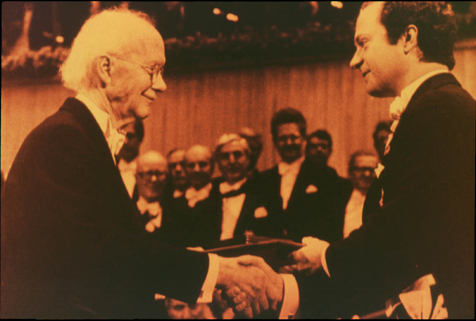
Faculty Research 1980 - 1989
In vitro synthesis of rat brain hexokinase.
Document Type
Article
Publication Date
1985
Keywords
Antibodies-Monoclonal, Brain: en, Hexokinase: bi, Hydrolysis, Immunochemistry, In-Vitro, Poly-A: me, Precipitation, Protein-Conformation, Protein-Processing-Post-Translational, Rats, RNA-Messenger: me, SUPPORT-U-S-GOVT-P-H-S, Translation-Genetic, Trypsin
First Page
186
Last Page
192
JAX Source
Biochim-Biophys-Acta. 1985 Dec 13; 843(3):186-92.
Grant
NS09910
Abstract
Hexokinase (ATP:D-hexose 6-phosphotransferase, EC 2.7.1.1) has been synthesized in the rabbit reticulocyte lysate system directed by poly(A)+ mRNA isolated from rat brain. Identification of the in vitro synthesis product as hexokinase was based on its immunoprecipitation with anti-hexokinase serum as well as the generation of identical peptide maps after partial cleavage of the in vitro product and authentic hexokinase with Staphylococcus aureus V8 proteinase or chymotrypsin. The in vitro product and authentic hexokinase were indistinguishable in molecular weight (SDS-gel electrophoresis); thus, despite the fact that, in situ, much of the hexokinase in brain is found in association with mitochondria, it is not synthesized in the form of a higher molecular weight precursor as is characteristic of other mitochondrial proteins. This is in accord with the view that hexokinase is best considered as a classical 'soluble' enzyme which is capable of exhibiting reversible association with mitochondria. The in vitro product cochromatographs (during anion-exchange HPLC) with authentic hexokinase previously shown to have a blocked (presumably acetylated) N-terminus; this procedure is capable of resolving the N-terminally blocked form of the enzyme from a partially proteolyzed form having a free N-terminal amino group. Thus the in vitro product is apparently N-acetylated by an enzyme system previously shown to be present in reticulocyte lysates. A significant fraction of the in vitro synthesized hexokinase attained a conformation characteristic of the native enzyme as judged by the observations that it could be immunoprecipitated by monoclonal antibodies recognizing the native enzyme but not by antibodies recognizing denatured hexokinase, and limited tryptic cleavage of the in vitro product gave fragments identical to those seen with the native enzyme and thought to reflect the organization of structural domains in that enzyme. However, based on these same criteria, the majority of the hexokinase synthesized in vitro appears to exist in a folding state that is not identical to that of either the fully denatured or native enzyme.
Recommended Citation
Pittler SJ,
Kozak LP,
Wilson JE.
In vitro synthesis of rat brain hexokinase. Biochim-Biophys-Acta. 1985 Dec 13; 843(3):186-92.

